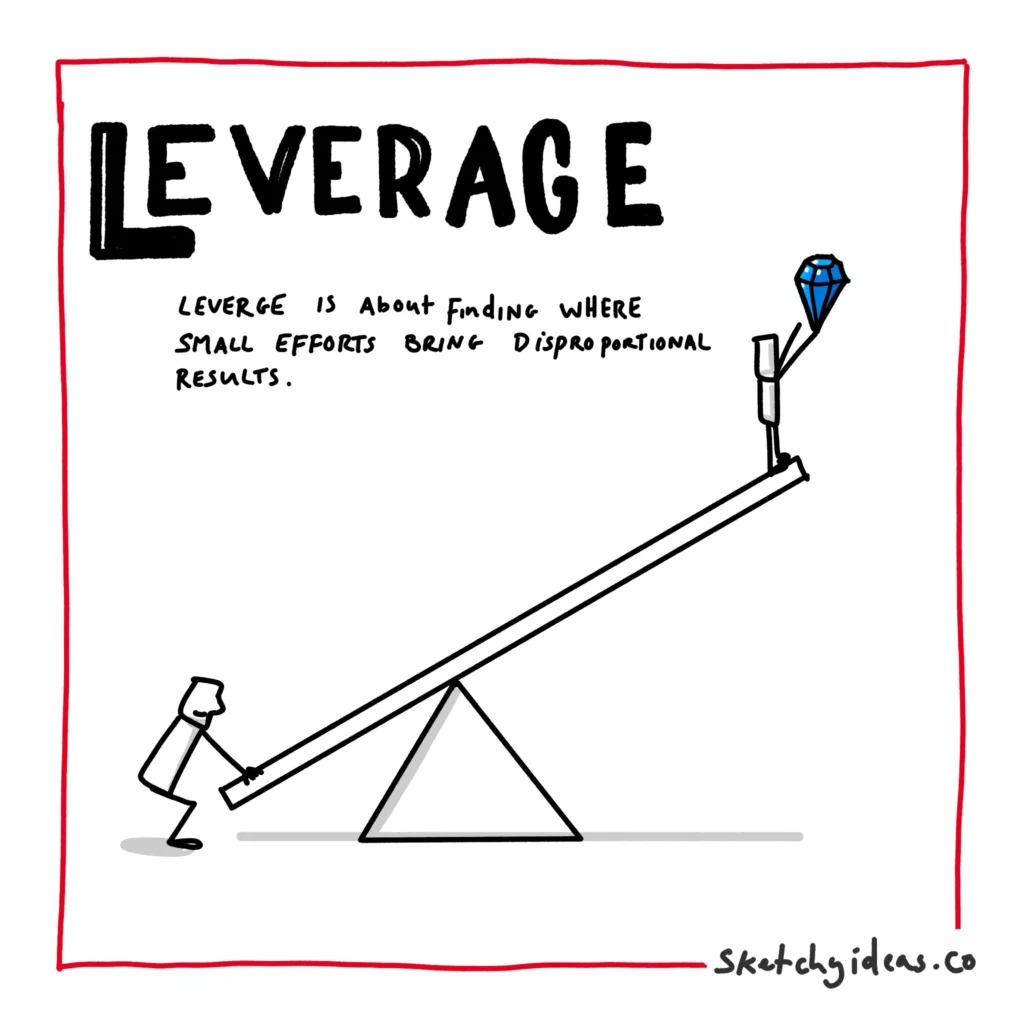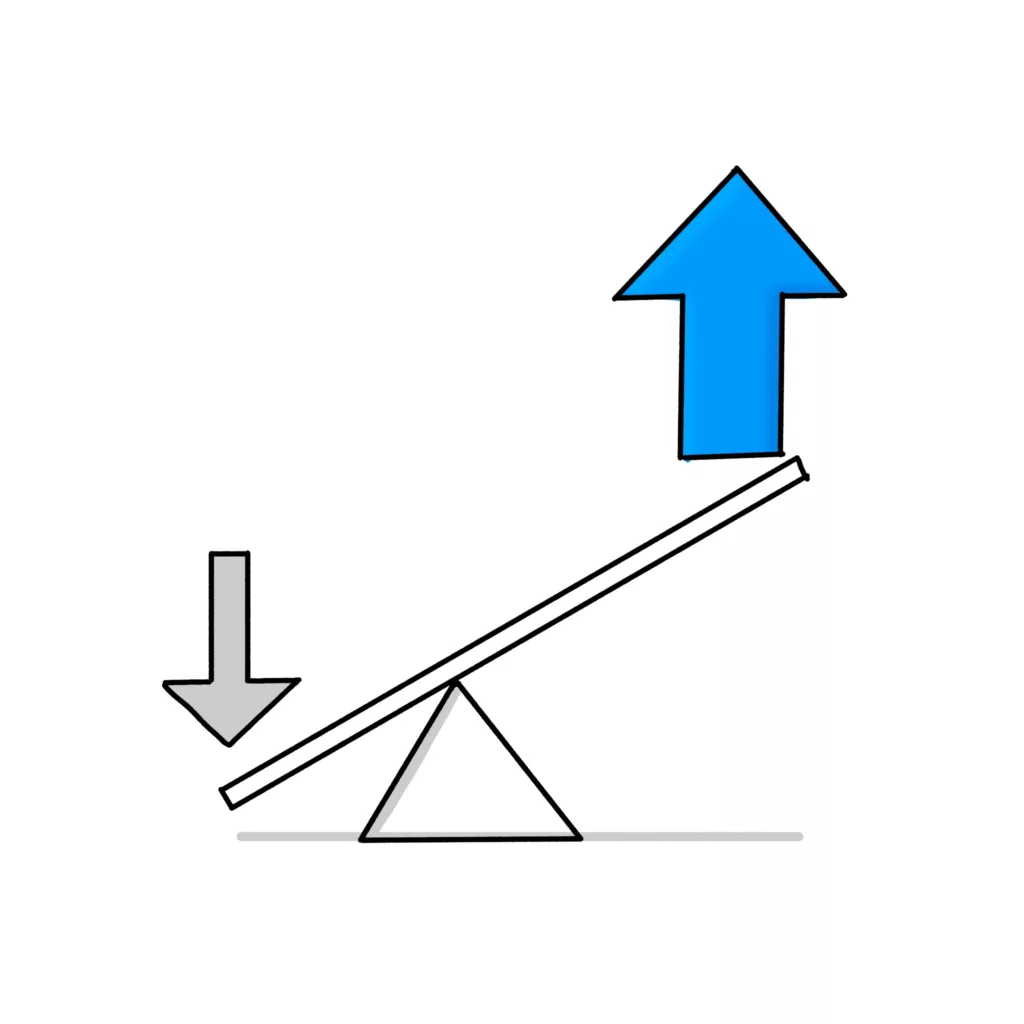Imagine moving a mountain with a small push.
Or, a more relatable example, spending an hour to set up a system that replaces an hour-long task you do every week.
That’s the power of the mental model of leverage.
In this article we’ll go through what it is, why it matters, and some ideas for how you can apply it in your day-to-day life.
So grab a pen and paper to take some notes, you going to want to remember this one.

What is Leverage?
The mental model of leverage comes from a principle in mechanics. A leaver can turn a small amount of energy into far more.
This can help move objects that couldn’t otherwise or make a task easier. It’s the same with the mental model. There are some situations and systems in life where a small effort can result in a dramatically larger output.

Finding and creating these opportunities is provides strategic advantages.
Why Leverage Matters?
We all have limited time and money.
Making the most of those resources means we can achieve greater results and preserve our resources for other meaningful activities. This is true of time, money, relationships and more. Finding high-leverage opportunities means you’ll achieve the most, with the least effort.
A practical case study: my unsuccessful startup story
Last year I was the sole marketing person for a small startup creating a app for podcasting for Apple devices.
There were thousands of actions I could do each day, but not enough time to do them all. With our limited financial runway, we needed to increase revenue fast to achieve sustainability. What we needed was high leverage actions.
Unfortunately, I didn’t pick the best options.
Some good ideas didn’t work out how I had hoped, and I also employed some consistent, long-term actions that never had the time to kick in. While the fault wasn’t mine alone, there were some technical issues with the app and some coordination issues, I know I didn’t give it the best shot we had.
And that’s despite employing some high leverage decision making strategies.
How to Use Leverage in Your Day to Day Life:
There are three quick and simple ways to start using the mental model of leverage every day.
- Use leverage as a factor in decision making
- Automate processes to save time and increase consistency
- Build one, sell twice
Leverage as a decision making tool
Next time you are considering a few plans or options, look at the potential leverage.
The simplest way is to give each option a score from 1-3 in terms of impact (3 = high impact, 1 = low) and 1-3 in terms of effort (3 = low effort, 1 = high). Multiple the numbers together, and the highest number items should be you high leverage opportunities (9 = High impact, low effort).
This model is a massive simplification but useful where there is a lot of ambiguity over actual time or impact.
When you have more data, you can apply a more scientific method such as
Expected results / expected time = score.
Sticking with blog articles, if you expect one will get 10x the views, but take 2x as long, you will see it’s still worth the extra time. But if you reverse those numbers, it won’t be. Just remember to mitigate Hofstadter’s law by using the worst time prediction not your best or average.
Automate your way to high leverage
Automation is a powerful time and effort efficacy tool.
By setting up a process that saves you minutes each week, you can save hours a year. But the benefits go beyond just time savings. You also make sure a process happens rather than trusting a human to have the motivation and time to do it.
Take investing for example.
Due to the law of compounding, it’s key to make regular, long term investments to take advantages of its power. Skipping one week or month might not matter, but skipping 50% makes a huge difference. What’s the solution?
Automatic investments.
Build once, sell twice
99% of the time, a problem isn’t unique.
There’s at least a handful of other people suffering the same issue, maybe more. So if you solve a problem for someone once, you can sell that solution to others. That’s a far better time-value return than solving another problem from scratch.
Here’s an example.
Imagine you design websites. Someone approaches you to design a photography website for them, with images front and centre. You create a beautiful design and the client is delighted.
You can use some of those same principles to make a generic theme other photographers can buy from your site.
Leverage: The Art of Getting More Bang for Your Buck
Leverage should be one of the foundational principles you use for making decisions.
By ignoring it you can waste time, effort, and money on less effective solutions just because “it’s the way we’ve always done it” or some other factor. And while there may be other factors that guide your decisions at times, such as meaning or fun, leverage can even play a role there.
If you want to make the most of your life, make sure you use this mental model.

Leave a Reply